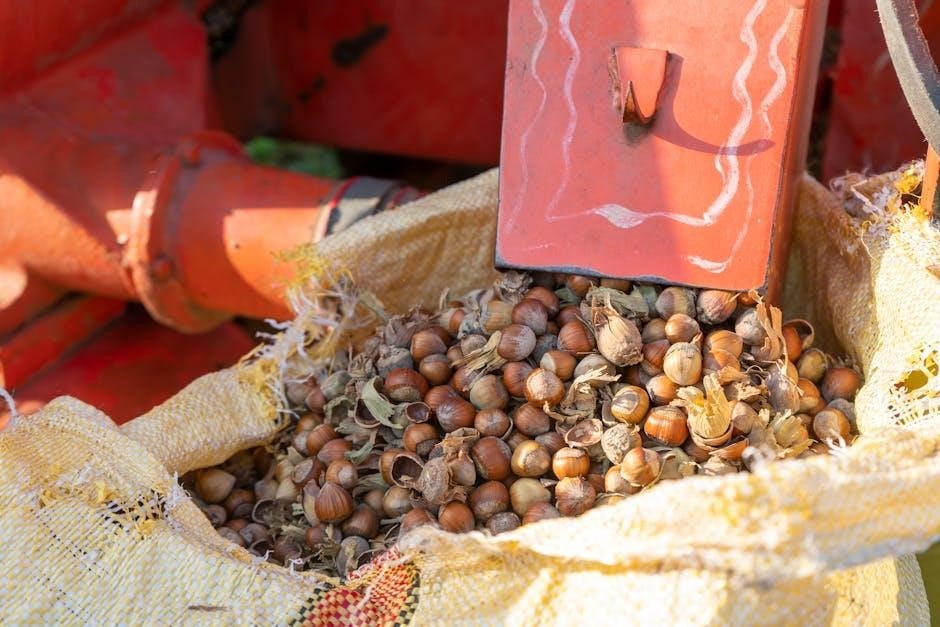Welcome to the Cuisinart Bread Machine guide! This essential kitchen appliance simplifies bread-making with ease. Perfect for home bakers, it offers versatile features. This guide covers setup, operation, and maintenance, ensuring perfect loaves every time, whether you’re a novice or experienced baker.
1.1 Safety Precautions
Before using your Cuisinart Bread Machine, it’s essential to follow these safety precautions to ensure safe and effective operation. READ ALL INSTRUCTIONS, product labels, and warnings carefully. Avoid touching hot surfaces, as they can cause burns. Always handle the unit by its handles and never by the bread pan or other components. Unplug the machine before cleaning or when not in use. Keep children away from the machine while it is operating. Never immerse the bread maker in water or expose it to excessive moisture. Use oven mitts or tongs to remove the bread pan or bread, as they may be extremely hot after baking. Avoid using abrasive cleaners or scouring pads, as they may damage the machine’s surfaces. Regularly inspect the power cord and plug for damage. If damaged, do not use the machine until it is repaired. Properly store the machine in a cool, dry place when not in use. Following these precautions ensures your safety and extends the lifespan of your bread maker.
Operating Instructions
Operating your Cuisinart Bread Machine is straightforward. Place ingredients in the bread pan, secure it, and select your desired program. Press START/STOP to begin. Use the delay timer for convenience, ensuring freshly baked bread when you need it. Follow program settings for perfect results.
2.1 Preparing the Machine

Before using your Cuisinart Bread Machine, ensure it is properly prepared. First, place the bread pan into the machine, making sure it is securely locked in position. Attach the kneading paddle to the bread pan to ensure proper mixing and kneading. Next, wipe the machine with a clean cloth to remove any dust or residue. Place the machine on a stable, heat-resistant surface, away from children and flammable materials. Always unplug the machine before cleaning or performing maintenance. Check the power cord and plugs for any damage before use. Allow the machine to cool completely after each use to prevent overheating. For optimal performance, familiarize yourself with the control panel and its functions. Finally, ensure all parts are in good condition and free from wear or damage. Proper preparation ensures safe and efficient operation, leading to perfectly baked bread every time.
2.2 Loading Ingredients

Properly loading ingredients is crucial for optimal bread-making results. Start by placing all ingredients into the bread pan in the order specified by the recipe. Typically, this includes liquids at the bottom, followed by dry ingredients, and yeast on top. Ensure the bread pan is securely locked into the machine to prevent movement during operation. Once loaded, press the START/STOP button to begin the cycle. Always measure ingredients accurately and avoid overfilling the pan, as this can lead to uneven mixing or overflow. For best results, use rapid rising yeast when utilizing the Last-Minute Loaf cycle. Never exceed the recommended flour capacity, as this can damage the machine or affect performance. Finally, ensure all optional ingredients, such as nuts or seeds, are added at the correct time, usually when the machine signals. Proper loading ensures even mixing, kneading, and baking, resulting in a perfectly baked loaf every time.
2.3 Selecting Programs
Selecting the right program on your Cuisinart Bread Machine is essential for achieving perfect results. The machine offers various preset programs, including Basic/White, Whole Wheat, Sweet, and Dough/Pizza Dough. To choose a program, press the PROG button until the desired option is displayed. For crust preference, use the Crust Color button to select light, medium, or dark. The machine also features a Delay Start Timer, allowing you to program the bread maker up to 13 hours in advance. For example, you can set it to start baking at 8 p.m. and have fresh bread ready the next morning. The Last-Minute Loaf cycle is ideal for rapid recipes, requiring the use of rapid rising yeast. Always ensure the program matches your recipe type for optimal performance. This versatility ensures you can customize your bread-making experience to suit any recipe or schedule, making the Cuisinart Bread Machine a convenient and efficient addition to your kitchen.
2.4 Starting the Machine
Once the bread pan is securely locked into the machine and all settings are configured, press the START/STOP button to begin the bread-making process. The machine will emit a beep to confirm it has started. Ensure the bread pan is properly secured and the kneading paddle is in place before starting. For delayed baking, use the Delay Start Timer to set the machine up to 13 hours in advance. Once activated, the machine will automatically mix, knead, rise, and bake the dough according to the selected program. If desired, monitor the process or intervene during the paddle signal to reshape the dough. The Last-Minute Loaf cycle is ideal for rapid recipes, requiring the use of rapid rising yeast. Always verify that the selected program aligns with your recipe type. Once started, the machine will handle the entire process, ensuring a perfectly baked loaf. Follow these steps carefully to enjoy fresh, homemade bread with minimal effort.
2.5 The Last-Minute Loaf Cycle
The Last-Minute Loaf cycle is a convenient feature designed for quick bread recipes. This cycle is specifically tailored for use with rapid rising yeast, which accelerates the fermentation process. To use this cycle, ensure all ingredients are added in the correct order, and the bread pan is securely locked into the machine. Once the cycle is selected, the machine will perform an abbreviated kneading and rising process before baking. This cycle is ideal for when you’re short on time but still want to enjoy freshly baked bread. Note that this cycle is best suited for white bread recipes and may not be appropriate for denser or gluten-rich dough. Always refer to the recipe and machine guidelines to ensure optimal results. By utilizing the Last-Minute Loaf cycle, you can achieve a delicious, homemade loaf with minimal preparation and time, making it a perfect option for busy households.
Programming Features
The Cuisinart Bread Machine offers versatile programming features, including a delay start timer and custom settings. These allow you to schedule baking up to 13 hours in advance and tailor settings like crust color, loaf size, and specific cycles for personalized results.
3.1 Delay Start Timer
The delay start timer on your Cuisinart Bread Machine allows you to schedule baking up to 13 hours in advance. Simply load the ingredients, select the desired program, and set the timer. The machine will automatically start the process at the designated time, ensuring fresh bread is ready when you need it. This feature is perfect for busy schedules, enabling you to wake up to freshly baked bread or have a loaf ready for dinner. For example, you can program the machine at 8 p.m. to finish baking by morning. The timer is easy to use, with clear controls that let you set the delay with precision. Always ensure the machine is placed on a stable, heat-resistant surface and plugged into a reliable outlet to avoid any interruptions during the delay period.
3.2 Custom Settings
The Cuisinart Bread Machine offers customizable settings to tailor your bread-making experience. Users can select from various programs, including Basic, French, Whole Wheat, Sweet, and Dough, to suit their recipe needs. Additionally, the machine allows you to choose crust color (light, medium, or dark) and loaf size (1, 1.5, or 2 pounds), ensuring your bread is baked to your preference. The custom settings also enable you to adjust kneading, rising, and baking times, providing flexibility for unique recipes or special dietary needs. The intuitive LCD display and navigation buttons make it easy to explore and modify these settings. Whether you’re experimenting with new ingredients or perfecting a family recipe, the custom settings on your Cuisinart Bread Machine give you the control to create delicious, personalized loaves. This feature is particularly useful for experienced bakers who want to fine-tune their results or for those exploring advanced bread-making techniques.

Ingredients and Measurements
Accurate ingredient measurements are crucial for perfect bread. Always add ingredients in the specified order: liquids, dry ingredients, and yeast last. Use a digital scale for precise measurements. Optional ingredients like fruits or nuts can be added during the kneading phase.

4.1 Ingredient Order
When using your Cuisinart bread machine, it’s essential to follow the correct order of ingredients to ensure proper mixing and rising. Always place liquids (such as water, milk, or eggs) at the bottom of the bread pan. This helps prevent the yeast from coming into contact with liquid too early, which could activate it prematurely. Next, add dry ingredients like flour, sugar, and salt. Finally, place the yeast on top of the dry ingredients to ensure it’s not submerged in liquid until the machine starts mixing. This order promotes even distribution and proper activation of the yeast. Optional ingredients, such as nuts or herbs, should be added during the kneading phase, usually when the machine signals. Always measure ingredients accurately using a digital scale or measuring cups to achieve the best results. Proper ingredient order and measurements are critical for producing a light, evenly textured loaf of bread.

4.2 Measuring Ingredients
Accurate measurement of ingredients is crucial for achieving the perfect loaf when using your Cuisinart bread machine. Use a digital scale or measuring cups to ensure precise quantities, as incorrect measurements can lead to dense or misshapen bread. Always scoop flour lightly into the measuring cup and level it with a knife to avoid overpacking. Liquids should be measured using a clear measuring cup to ensure accuracy. For yeast, use the specified amount, as too much can cause the dough to rise too quickly, while too little may result in poor rise. Salt and sugar should also be measured precisely, as they play key roles in flavor and yeast activity. Avoid estimating measurements, as this can lead to inconsistent results; For best performance, use room-temperature ingredients and fresh yeast. Proper measurement ensures the machine processes the dough correctly, delivering a light and evenly textured loaf every time.

4.3 Optional Ingredients

Customize your bread with optional ingredients to create unique flavors and textures. Nuts, seeds, herbs, cheeses, and dried fruits are popular additions. Add these ingredients during the dough cycle or when the machine signals. Use up to 1/2 cup of mix-ins to avoid overwhelming the dough. Toast nuts or seeds lightly for enhanced flavor. Rehydrate dried fruits in water or liquor before adding for optimal texture. For herbs or spices, start with small amounts (1-2 tablespoons) and adjust to taste. Cheese should be grated or crumbled finely. Ensure ingredients are evenly distributed to maintain loaf structure. Avoid overmixing, as this can damage the dough. Experiment with combinations like rosemary and olive oil or cranberries and orange zest for creative recipes. Always consider allergies and ingredient freshness for the best results. Optional ingredients allow you to personalize your bread, making every loaf a new culinary experience.

Maintenance and Cleaning
Regular maintenance ensures longevity. Unplug the machine before cleaning. Wipe exterior with a damp cloth and dry thoroughly. Clean the bread pan and kneading paddle by hand with mild soap. Allow the machine to cool before storing it in a dry place to prevent moisture buildup and maintain optimal performance.
5.1 Cooling Down
Proper cooling is essential for your Cuisinart Bread Machine’s longevity. Always unplug the machine before cleaning or storing. Allow it to cool completely to avoid moisture buildup, which can lead to mold or electrical issues. Never pour water or cleaning solutions directly onto the machine, as this can damage internal components. After each use, let the machine sit unplugged for at least 30 minutes to cool down naturally. This ensures all parts return to room temperature, preventing warping or damage. Regularly cleaning the exterior with a damp cloth during the cooling phase helps maintain hygiene and appearance. Proper cooling also prevents overheating during subsequent uses, ensuring consistent performance. Follow these steps to keep your bread maker in great working condition and extend its lifespan.
5.2 Cleaning the Machine
Regular cleaning is crucial for maintaining your Cuisinart Bread Machine’s performance and hygiene. Always unplug the machine before cleaning to ensure safety. Use a soft, damp cloth to wipe down the exterior, removing any crumbs or splatters. For tougher stains, a mild soap solution can be used, but avoid harsh chemicals or abrasive cleaners that may damage the finish. The bread pan and kneading paddle should be washed by hand with warm, soapy water or placed in the dishwasher, depending on the model. Remove and clean the crumb tray regularly to prevent buildup. Dry all parts thoroughly before reassembling to prevent rust or water spots. Never submerge the main unit in water, as this can cause electrical damage. Cleaning after each use prevents dough residue from hardening and makes maintenance easier. Proper care ensures your bread maker remains in excellent condition and continues to produce perfect loaves.
5.3 Storage Tips
Proper storage of your Cuisinart Bread Machine ensures longevity and maintains its performance. Always unplug the machine and allow it to cool completely before storing. Clean the machine thoroughly, paying attention to the bread pan and kneading paddle, to prevent dough residue from hardening. Store the machine in a cool, dry place, away from direct sunlight and moisture. Avoid storing it near ovens or heaters to prevent damage from heat. For the bread pan and accessories, place them in a separate, dry container to avoid scratching or bending. If storing for an extended period, cover the machine with a breathable cloth to protect it from dust. Do not store the machine in humid environments, as this may lead to mold or rust. By following these storage tips, you can keep your Cuisinart Bread Machine in excellent condition and ready for its next use.

Troubleshooting Common Issues
Encountering issues with your Cuisinart Bread Machine? Don’t worry—most problems can be easily resolved. If the machine doesn’t start, ensure it’s properly plugged in and the bread pan is securely locked. For uneven mixing, check that ingredients are loaded in the correct order and the kneading paddle is properly attached. If the crust is overcooked, adjust the crust color setting or reduce oven exposure during baking. Dough not rising? Verify yeast freshness and ensure the machine is at room temperature. If the machine stops mid-cycle, unplug it, let it cool, then restart. For persistent issues, consult the user manual or contact Cuisinart support. Regular cleaning and maintenance can also prevent many common problems. By addressing these issues, you can ensure consistent and delicious bread-making results.
